The Change Management Software Market is estimated to be valued at USD 244.3 billion in 2025 and is projected to reach USD 552.6 billion by 2035, registering a compound annual growth rate (CAGR) of 8.5% over the forecast period.
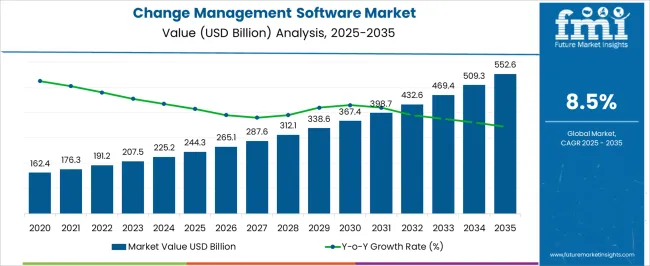
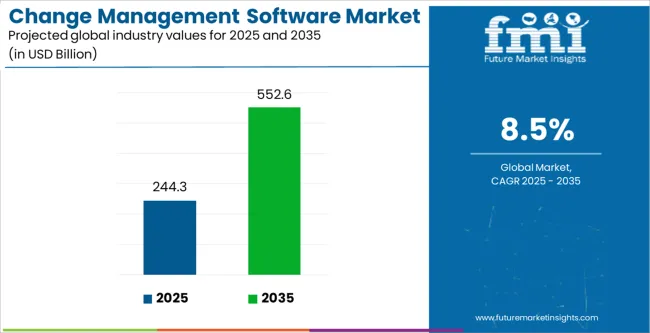
| Metric | Value |
|---|---|
| Change Management Software Market Estimated Value in (2025 E) | USD 244.3 billion |
| Change Management Software Market Forecast Value in (2035 F) | USD 552.6 billion |
| Forecast CAGR (2025 to 2035) | 8.5% |
The change management software market is expanding steadily, supported by the growing digital transformation initiatives across enterprises and the rising need to streamline organizational workflows. Increasing complexities in IT environments, combined with frequent system upgrades and compliance requirements, are driving adoption.
Organizations are seeking solutions that minimize disruption, reduce operational risks, and ensure seamless communication during transitions. The integration of AI powered analytics and automation capabilities has further enhanced the efficiency of change management platforms, making them central to modern IT and business operations.
As enterprises continue to prioritize agility, governance, and employee adoption in the face of rapid technological advancements, the market outlook remains highly promising with strong growth opportunities in multiple industries worldwide.
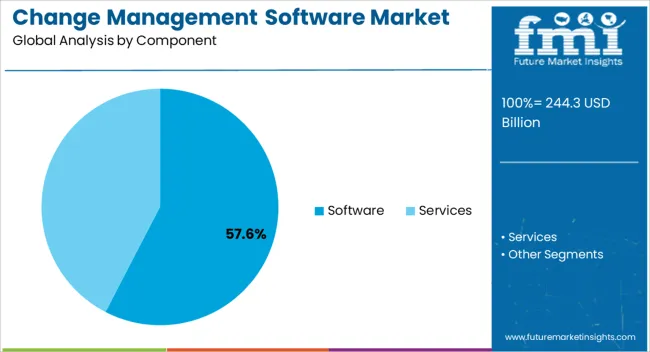
The software segment is expected to represent 57.60% of the total market revenue by 2025, positioning it as the leading component. This growth is attributed to the widespread adoption of comprehensive platforms that enable efficient planning, execution, and monitoring of organizational changes.
The scalability, automation features, and integration capabilities offered by these solutions are highly valued by enterprises seeking cost efficiency and operational control. Additionally, continuous innovation in user friendly dashboards, predictive analytics, and cloud enabled functionalities has strengthened their role.
These factors collectively have driven the dominance of the software segment within the component category.
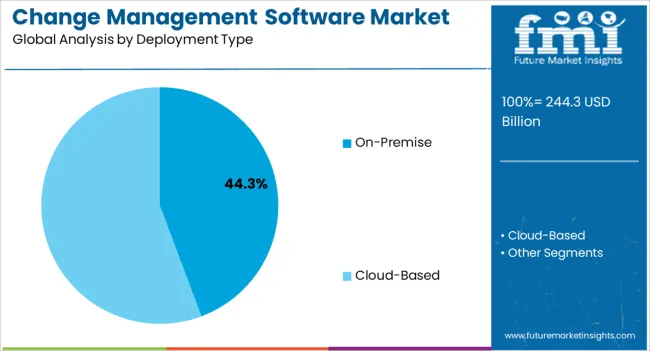
The on premise segment is projected to account for 44.30% of the market revenue by 2025, making it the leading deployment type. This preference is driven by organizations that prioritize data control, regulatory compliance, and customized integration within existing IT infrastructures.
Sensitive industries such as healthcare, finance, and government entities continue to rely heavily on on premise solutions to ensure enhanced security and uninterrupted operations.
Despite the growth of cloud models, the demand for robust internal management and compliance with data governance policies has reinforced the dominance of on premise deployment in the market.
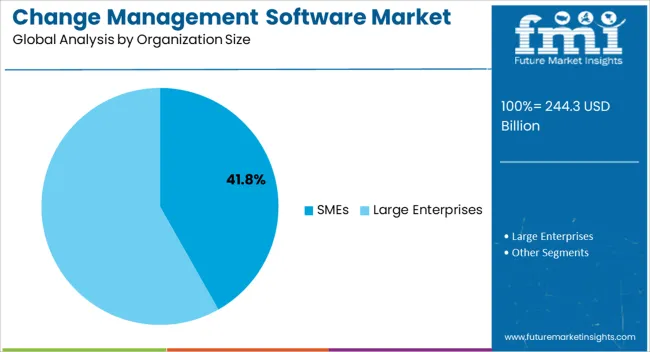
The SMEs segment is projected to contribute 41.80% of overall revenue by 2025, establishing it as the leading organization size. This is attributed to the growing recognition among small and medium enterprises of the importance of structured change processes for scaling operations and adopting digital transformation initiatives.
SMEs often face resource constraints and require cost effective, adaptable software solutions that ensure smooth transitions and reduce risks. The increasing availability of flexible licensing models and modular software has made adoption more accessible for SMEs.
As these organizations continue to modernize their processes and embrace automation, their reliance on change management software has expanded significantly, strengthening their leadership position in this segment.
The demand for change management software is anticipated to rise as it allows the traceability of changes as well as the support of the change process in a system.
The fundamental goal of change management software is to ensure that changes are implemented in a safe and controlled manner while also controlling risk. The market is being driven by the growing sales of change management software and the demand for consistent means of change evolution in the IT and telecommunications sectors.
The growing demand for change management software for the governance of change structures in making informed decisions and the need for risk management analysis in organizations.
The growing cyberthreats across businesses has surged the demand for change management software. The rise in cyber threats and cybercrime has heightened the demand for risk mitigation in end-user businesses. The software enable the businesses to overcome risks and combat the threats.
The sales of change management software are rising as it improves the financial and strategic performance of the business, resulting in a higher Return on Investment (ROI).
A social engineering or polishing attack is also a common component of cyber threats. Change management software is used to counteract these attacks, thereby driving the demand of the market during the forecast period. Enterprises can use change management software to understand the risk and the modifications needed to mitigate it.
The growing demand for consumer electronic such as, smartphones, laptops, and tablets has propelled the demand for the market. In addition, the developing IT & Teecom industries is expected to surge the market growth over the forecast period.
The demand for change management software is growing as it helps to eliminate resistance, boost creativity, increase job efficiency, and lower costs. The sales of the software are rising as it is widely used in the IT & Telecom industries.
The International Trade Administration (ITA) stated that 50% of enterprises in the USA have deployed Cloud Access Security Broker (CASB) technology for around 1,000 users. The aim of these businesses is to monitor and control their use of software as a service
The rising demand for change management software and cloud computing has increased the vulnerability of cloud networks to attacks. These advantages has boomed the adoption of cloud-based CMS software.
In addition, the usage of CMS technologies in vulnerability assessments is anticipated to fuel the sales of change management software during the forecast period.
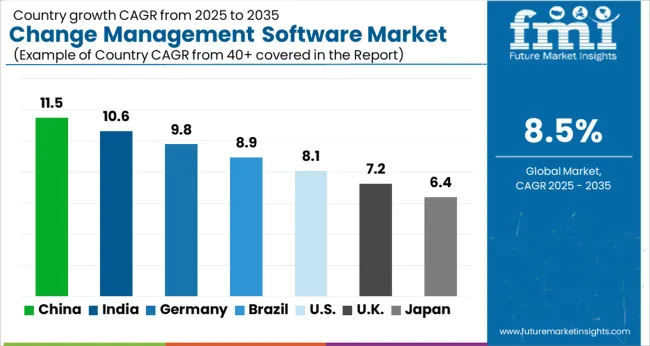
Over the forecast period, Asia Pacific is anticipated to witness the highest growth in the change management software market. China and India are regarded as high-demand markets for change management software, with CAGRs of 9.6% and 9.4%, respectively.
Businesses strive to provide quick access to accurate records, protect themselves from cybersecurity risks, and perform critical duties. Such as decreasing outages and breaches while lowering costs.
Due to the growth in IT infrastructures in China, numerous businesses have turned their attention to configuration management. The demand for change management software solutions in the region has been driven by the optimization of IT asset maintenance to avoid discrepancies.
According to the Small and Medium Enterprise Agency (SMEA) of Japan, 99.7% of functional industries come under the small and medium enterprise (SME) group. Making Japan an excellent country for configuration management solutions in the APAC region.
SMEs have favored low to medium-cost options, such as change management software, over ERP solutions because of financial constraints and a lack of IT infrastructure.
For the change and configuration management sector, the Asia Pacific region is quickly becoming one of the fast-growing regions. Change management is emerging as a solution to help global companies cope with frequent challenges that come when dealing with worldwide teams. New expansion regions, and an influx of data as they expand their reach into the Asia Pacific and boost their investments in IT initiatives.
| Category | By Deployment Mode |
|---|---|
| Leading Segment | On-Premises |
| Market Share (2025) | 58.7% |
| Category | By component Type |
|---|---|
| Leading Segment | Software |
| Market Share (2025) | 63.4% |
In the change management software market, cloud-based deployment is gaining traction at 11.9%. Though, the on-premise segment leads the market as it held a market share of 58.7% in 2025. The ability to swiftly expand business demands and the shift of customers to the cloud as a result of reduced IT overcapacity are the key reasons driving the growth of cloud-based deployment.
Many public cloud providers are configuring change management on the cloud since they have various tools for installations. Leading to the deployment of cloud-based change management software by many enterprises.
Due to the increased use of cloud networking and expanding internet penetration internationally, the use of cloud-based subscriptions such as Software-as-a-Service (SaaS) has expanded. These factors are propelling the demand for change management software forward.
Due to the increase in small and medium businesses in developing countries, SMEs are dominating the change management software market. Furthermore, small businesses are using cloud-based networking for their business operations. Such as asset management, blockchain, and others, which is boosting the sales of change management software.
Due to the use of cloud computing, small and medium businesses are dominating the market for change management software, necessitating the demand for change management software in these businesses.
According to the World Bank, small and medium-sized businesses account for 90% of all businesses. Small and medium-sized businesses (SMEs) generate 40% of national income (GDP) in emerging economies. Furthermore, the CMS's increased agility in business operations contributes to the growth of small and medium enter.
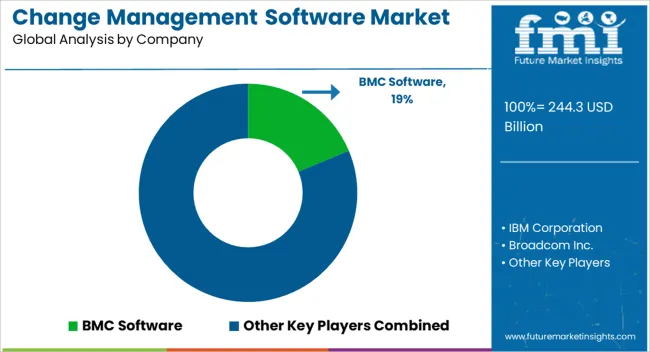
More than half of the market is controlled by a few leading players. The expansion of these firms in the field of cloud technologies coupled with artificial intelligence (AI), IoT, and other technologies is reflected in the analysis of significant market share for these companies.
Key players in the change management software market are concentrating their efforts on completing various business models to provide advanced change management solutions
Market Developments
The global change management software market is estimated to be valued at USD 244.3 billion in 2025.
The market size for the change management software market is projected to reach USD 552.6 billion by 2035.
The change management software market is expected to grow at a 8.5% CAGR between 2025 and 2035.
The key product types in change management software market are software and services.
In terms of deployment type, on-premise segment to command 44.3% share in the change management software market in 2025.






Full Research Suite comprises of:
Market outlook & trends analysis
Interviews & case studies
Strategic recommendations
Vendor profiles & capabilities analysis
5-year forecasts
8 regions and 60+ country-level data splits
Market segment data splits
12 months of continuous data updates
DELIVERED AS:
PDF EXCEL ONLINE
Change Control Management Software Market
Changeover Switch Market Size, Share, and Forecast 2025 to 2035
Change And Configuration Management Market Size and Share Forecast Outlook 2025 to 2035
Tire Changers - Market Growth - 2025 to 2035,
Interchangeable Biosimilars Market
Ion Exchange Resins Market Size & Forecast 2025 to 2035
Heat Exchanger Market Size and Share Forecast Outlook 2025 to 2035
VHF Data Exchange System (VDES) Market Forecast and Outlook 2025 to 2035
Currency Exchange Bureau Software Market – FinTech Evolution
Music Speed Changer Market Size and Share Forecast Outlook 2025 to 2035
Plate Heat Exchanger Market Growth - Trends & Forecast 2025 to 2035
Brewery Heat Exchanger Market Size and Share Forecast Outlook 2025 to 2035
Heat Moisture Exchanger Market Size and Share Forecast Outlook 2025 to 2035
Transformer Tap Changers and Voltage Control Relay Market Growth – Trends & Forecast 2025 to 2035
Inorganic Ion Exchange Materials Market
Air Cooled Heat Exchanger Market Size and Share Forecast Outlook 2025 to 2035
Automotive Heat Exchanger Market
Brazed Plate Heat Exchangers Market Size and Share Forecast Outlook 2025 to 2035
Shell & Tube Heat Exchangers Market
High Pressure Heat Exchanger Market

Thank you!
You will receive an email from our Business Development Manager. Please be sure to check your SPAM/JUNK folder too.
Chat With
MaRIA